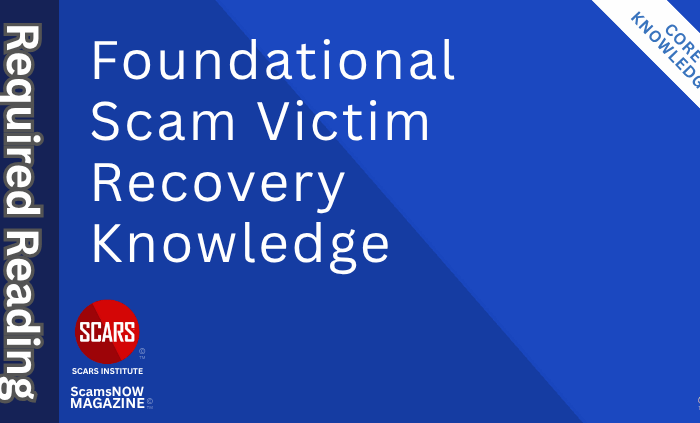How to Kill ANTs in Your Brain (Automatic Negative Thoughts) for Scam Victims
Automatic Negative Thoughts that Interfere in Scam Victims’ Recovery
Primary Category: Scam Victim Recovery Psychology
Intended Audience: Scam Victims-Survivors / Family & Friends
Authors:
• Vianey Gonzalez B.Sc(Psych) – Licensed Psychologist, Specialty in Crime Victim Trauma Therapy, Neuropsychologist, Certified Deception Professional, Psychology Advisory Panel & Director of the Society of Citizens Against Relationship Scams Inc.
• Tim McGuinness, Ph.D., DFin, MCPO, MAnth – Anthropologist, Scientist, Polymath, Director of the Society of Citizens Against Relationship Scams Inc.
About This Article
Scam victims often struggle with overwhelming guilt, shame, and self-blame, leading to repetitive and intrusive Automatic Negative Thoughts (ANTs) that make recovery difficult. These thoughts—such as “I’m so stupid” or “I’ll never recover”—arise automatically and reinforce emotional distress, trapping victims in a cycle of negativity. ANTs are not just mental habits; they have a neurological basis, stemming from the brain’s fear and survival mechanisms, particularly the amygdala and limbic system.
They also thrive within the Default Mode Network (DMN), a brain system that becomes active when the mind is at rest, causing excessive rumination. Breaking free from ANTs requires a deliberate effort to rewire the brain by challenging negative thoughts, redirecting attention to meaningful tasks, and engaging in physical movement.
Cognitive restructuring, mindfulness, and structured daily routines help disrupt ANTs and deactivate the DMN, allowing scam victims to regain control of their thoughts. By practicing self-compassion, setting achievable goals, and focusing on purposeful action, victims can retrain their minds to focus on growth rather than regret, ultimately rebuilding their confidence and emotional resilience.

How to Kill ANTs (Automatic Negative Thoughts) that Interfere in Scam Victims’ Recovery
Scam victims often struggle with overwhelming guilt, shame, and self-blame after being deceived. One of the most destructive mental patterns that can take hold during this period is automatic negative thoughts (ANTs)—those intrusive, repetitive, and self-defeating thoughts that seem impossible to turn off. These thoughts create a cycle of emotional suffering, preventing victims from healing, regaining self-confidence, and moving forward with their lives.
By understanding what ANTs are, how they function in the brain, and how to effectively counter them, scam victims can take back control of their thoughts and emotions. Drawing from neuroscience, psychology, and the insights of thinkers like Jordan Peterson, this article will provide a structured guide on how to “kill” ANTs and replace them with healthier mental patterns.
What Are Automatic Negative Thoughts (ANTs)?
Automatic Negative Thoughts are involuntary, repetitive, and self-critical thoughts that arise in response to stress, trauma, or uncertainty. For scam victims, ANTs often take the form of:
- Self-blame: “How could I have been so stupid?”
- Catastrophizing: “I’ll never recover from this.”
- Hopelessness: “My life is ruined forever.”
- Distrust: “I can’t trust anyone anymore.”
- Shame: “Everyone must think I’m a fool.”
These thoughts feel automatic because they arise reflexively and without conscious effort. They can dominate the mind, reinforcing a victim’s sense of helplessness and making it difficult to regain a sense of normalcy.
The Psychology and Neuroscience of ANTs
ANTs don’t just happen randomly—they are deeply tied to how the brain processes emotional experiences, especially negative ones.
The Role of the Amygdala: The amygdala, the brain’s threat detection center, plays a crucial role in triggering negative thoughts. When a scam victim experiences betrayal or financial loss, the amygdala registers this as a serious threat. As a survival mechanism, it keeps replaying the painful event in an attempt to “solve” the problem or prevent it from happening again. Unfortunately, this repeated activation strengthens negative thinking patterns.
The Prefrontal Cortex and Rational Thinking: The prefrontal cortex, responsible for rational thought and problem-solving, is often overridden when ANTs take control. Instead of analyzing the situation logically, the victim’s brain loops through negative emotions, reinforcing the belief that they were weak, foolish, or beyond recovery.
Neuroplasticity and Habit Formation: The more a person engages in negative thinking, the stronger these thought patterns become. The brain reinforces frequently used neural pathways, making them habitual. This means that the more a scam victim repeats self-blaming thoughts, the easier it becomes for the brain to generate them automatically. However, the good news is that neuroplasticity—the brain’s ability to rewire itself—allows for new, healthier thought patterns to form with practice.
The Brain’s Default Mode
ANTs as the Default Mode: Understanding Why Negative Thoughts Take Over
One of the biggest challenges scam victims face is that automatic negative thoughts (ANTs) seem to arise effortlessly, dominating the mind without any conscious effort. This happens because the brain has a built-in tendency to default to negative thinking, especially after trauma or a distressing event. This tendency is linked to what neuroscientists call the Default Mode Network (DMN).
What Is the Default Mode Network?
The Default Mode Network (DMN) is a system of brain regions that becomes active when the mind is not focused on a specific task. It’s what takes over when you’re daydreaming, reflecting on the past, or worrying about the future. While this network helps with self-awareness and memory processing, it also plays a major role in generating ANTs, particularly after a distressing experience like a scam.
For scam victims, the DMN can become a loop of regret, shame, and fear, repeatedly replaying the details of what happened, and asking unhelpful questions like:
-
-
-
- “How could I be so stupid?”
- “What if I never recover?”
- “Will I ever trust anyone again?”
-
-
Because the DMN runs automatically when the brain is at rest, ANTs become the default mental background noise, reinforcing a cycle of self-doubt and emotional distress.
Why the Brain Defaults to Negative Thinking
From an evolutionary perspective, the brain’s tendency to default to negative thoughts was originally a survival mechanism. In early human history, constantly scanning for threats helped our ancestors stay alive. But in today’s world, this mechanism can work against us—especially after a traumatic event like being scammed.
After a scam, the brain remains on high alert, treating the event as an unresolved “danger” that needs continuous attention. This causes the DMN to keep looping through negative thoughts, attempting to “solve” the situation, even when there’s nothing left to fix. The result is rumination, where a person gets trapped in repetitive, unproductive thinking.
How to Shut Down the Default Mode Network and Stop ANTs
Because ANTs are deeply connected to the brain’s default mode, they won’t go away on their own. Instead, scam victims need to disrupt the DMN and shift their brain into a more active, goal-oriented mode. Here’s how:
Engage in Focused Tasks
One of the best ways to interrupt ANTs is to focus your mind on something external. Since the DMN is most active when you’re not engaged in a specific task, doing something mentally demanding forces the brain to switch gears.
Try:
-
-
-
- Learning something new (reading, watching an educational video, or taking a course).
- Doing puzzles or problem-solving activities (crossword puzzles, Sudoku, chess).
- Writing or journaling (shifting thoughts from the brain onto paper can break the loop).
- Engaging in creative activities (painting, playing music, cooking).
-
-
Any intentional focus on a task helps deactivate the DMN, reducing the grip of ANTs.
Use Physical Movement to Disrupt the Loop
Because ANTs are tied to brain activity, changing physical state can help break their cycle. Movement forces the brain to shift from passive rumination to active engagement.
Try:
-
-
-
- Walking outside (especially in nature, which calms the nervous system).
- Exercise (aerobic activity like running, swimming, or cycling helps regulate brain chemistry).
- Stretching or yoga (mind-body practices help redirect attention and reduce stress).
-
-
Moving the body changes the neurochemical environment of the brain, making it harder for ANTs to dominate.
Practice Mindfulness and Present-Moment Awareness
Jordan Peterson often emphasizes that order must be created out of chaos. A great way to create order in the mind is through mindfulness, which pulls attention away from negative thoughts and into the present moment.
Try:
-
-
-
- 5-4-3-2-1 grounding technique:
- Identify 5 things you see
- Identify 4 things you can touch
- Identify 3 things you hear
- Identify 2 things you smell
- Identify 1 thing you taste
- Deep breathing exercises to calm the nervous system.
- Body scanning—slowly bringing awareness to different parts of your body to redirect attention.
- 5-4-3-2-1 grounding technique:
-
-
Mindfulness disrupts the DMN by bringing focus to what is happening now, rather than replaying past regrets.
Set Small, Achievable Goals
A lack of structure fuels ANTs. When the mind has no clear purpose, the DMN takes over, filling the void with rumination. One way to regain control is by creating small goals that give the mind direction and structure.
Try:
-
-
-
- Making a to-do list with small, manageable tasks.
- Setting a goal for the next hour (even something simple like making tea or organizing a desk).
- Using Jordan Peterson’s rule: “Clean your room”—starting with small, tangible actions to establish order.
-
-
Clear action steps shift the brain from passive mode (DMN) into active mode, reducing the chance for ANTs to take over.
Speak to Yourself Like Someone You Care About
One of Peterson’s most famous rules is: “Treat yourself like someone you are responsible for helping.”
Instead of allowing the default negative self-talk to dominate, consciously speak to yourself with the same kindness you would offer a friend.
Ask yourself:
-
-
-
- Would I say this to someone I love?
- Am I being fair to myself?
- What would a wise and kind mentor say to me right now?
-
-
By interrupting harsh inner dialogue and replacing it with self-compassion, you weaken the power of ANTs.
Take Back Control from the Default Mode
ANTs are powerful because they are deeply wired into the brain’s default processes. However, they are not permanent. With intentional effort, awareness, and structured actions, scam victims can interrupt the Default Mode Network and take control of their thoughts.
-
-
- Recognizing when ANTs are taking over is the first step.
- Engaging in focused tasks prevents the brain from looping in negativity.
- Using physical movement and mindfulness shifts attention away from rumination.
- Setting small goals creates structure, counteracting the aimless nature of ANTs.
- Practicing self-compassion helps replace destructive thoughts with constructive ones.
-
Neuroscience confirms that new thought patterns can be built. Just as the brain has learned to default to ANTs, it can learn new, healthier defaults with consistent practice.
By taking proactive steps, scam victims can reclaim their minds, rebuild their confidence, and move forward with strength and wisdom.
Automatic Negative Thoughts (ANTs) vs. the Brain’s Default Mode Network (DMN)
Understanding the Difference
When recovering from a scam, victims often find themselves trapped in negative thought cycles. They feel consumed by self-blame, regret, and anxiety about the future. These thought patterns are often described as Automatic Negative Thoughts (ANTs). However, ANTs do not exist in isolation—they are strongly influenced by a larger neurological system known as the Default Mode Network (DMN). While these two concepts are related, they operate in distinct ways. Understanding their differences can help scam victims break free from destructive thinking patterns and regain control over their minds.
What Are Automatic Negative Thoughts (ANTs)?
ANTs are involuntary, rapid, and repetitive negative thoughts that arise in response to situations or memories.
These thoughts are often irrational, exaggerated, and emotionally charged. They are automatic in the sense that they require no conscious effort—they simply emerge, usually in response to stress or trauma.
For scam victims, ANTs may sound like:
-
-
-
- “I am so stupid for falling for this.”
- “I’ll never recover from this.”
- “I can’t trust anyone ever again.”
- “People must think I’m a fool.”
- “Everything is ruined because of this scam.”
-
-
These thoughts are self-destructive distortions of reality. They do not reflect objective truth but rather an emotionally skewed interpretation of events.
How ANTs Work in the Brain
-
-
-
- Originate in the amygdala and limbic system, which control fear and emotional processing.
- Function as a survival response, exaggerating threats to prepare the brain for danger.
- Trigger stress reactions, increasing anxiety, tension, and negative emotions.
- Strengthen over time—the more ANTs occur, the stronger the neural pathways supporting them become.
-
-
Because ANTs are conditioned responses, they can be rewired and replaced with healthier thought patterns through cognitive and behavioral interventions.
What Is the Default Mode Network (DMN)?
The Default Mode Network (DMN) is a large-scale network in the brain that is most active when we are not focused on a specific task. It is responsible for self-reflection, mind-wandering, daydreaming, and replaying past events.
For scam victims, this means that whenever they are alone, unoccupied, or simply relaxing, their DMN may pull them back into thoughts about the scam, reinforcing guilt, shame, and regret.
How the DMN Works in the Brain
-
-
-
- Involves the medial prefrontal cortex, posterior cingulate cortex, and hippocampus, areas linked to memory, self-referencing, and emotions.
- Becomes active when the mind is at rest, leading to thoughts about past events, future scenarios, and self-evaluation.
- Helps process emotions and memories, but after trauma, it can become overactive and reinforce negative self-perceptions.
-
-
Key Differences Between ANTs and the DMN
Automatic Negative Thoughts (ANTs)
-
-
-
- Repetitive, negative thought patterns that occur automatically.
- Triggered by stress, trauma, or emotional distress.
- Act as a defense mechanism, preparing for danger.
- Rooted in the amygdala and limbic system.
- Cause excessive guilt, self-blame, and fear after a scam.
- Can be reduced through cognitive restructuring and mindfulness.
-
-
Default Mode Network (DMN)
-
-
-
- A brain system responsible for self-reflection and mind-wandering.
- Becomes active when the mind is not engaged in a task.
- Helps process past experiences and imagine future scenarios.
- Involves the medial prefrontal cortex, posterior cingulate cortex, and hippocampus.
- Can lead to overthinking and rumination after a scam.
- Can be disrupted by focused attention and structured activities.
-
-
While ANTs are specific negative thoughts, the DMN is the system that sustains and amplifies them. If left unchecked, these two forces create a self-reinforcing loop of negativity.
How to Interrupt ANTs and Reset the Default Mode Network
Because the DMN fuels ANTs, stopping ANTs requires shifting the brain out of default mode and into task-oriented thinking. Here’s how:
Actively Engage in a Task
Since the DMN is most active when you are idle, keeping the brain occupied forces it to shift out of rumination.
-
-
-
- Read a book or article.
- Listen to an educational podcast.
- Engage in a creative activity (painting, writing, or playing music).
- Do household chores like organizing or cleaning.
-
-
Engaging in a task helps break the ANTs loop and deactivate the DMN.
Challenge and Replace ANTs
-
-
-
- When an ANT arises, write it down.
- Challenge it with evidence:
- “Is this 100% true?”
- “What’s a more balanced way to see this?”
- Replace it with a more rational thought.
- Instead of “I’ll never recover”, say “Recovery takes time, and I’m taking steps forward.”
-
-
Replacing automatic thoughts rewires neural pathways over time.
Move Your Body
Physical activity changes brain chemistry, releasing neurotransmitters that reduce stress and override ANTs.
-
-
-
- Take a walk, especially in nature.
- Stretch or practice yoga.
- Do deep breathing exercises.
-
-
Physical movement breaks the DMN’s grip on repetitive thoughts.
Use External Verification
When in doubt, talk to a trusted person. Scam victims often assume “Everyone thinks I’m stupid”, but asking for an outside perspective can disprove this. Seeking feedback from reality-based sources helps override ANTs.
Create a Simple Structure for Your Day
-
-
- Set a morning routine (even something as simple as making your bed).
- Write a small to-do list to provide mental direction.
- Practice Jordan Peterson’s principle: “Clean your room.”
Having structure limits DMN activity, reducing ANTs.
-
Taking Control of Your Thoughts
ANTs and the DMN work together to create persistent cycles of negative thinking. However, by consciously engaging the brain in structured activities, practicing cognitive restructuring, and using mindfulness techniques, scam victims can interrupt the pattern and regain control.
-
- ANTs are the repetitive negative thoughts that arise automatically.
- The DMN is the mental state that keeps replaying and reinforcing them.
- Shifting the brain from passive to active mode is the key to stopping ANTs and calming the DMN.
Scam victims do not have to be prisoners of their own thoughts. With deliberate effort, they can break free from ANTs, shift out of the default mode, and begin the process of healing and recovery.
How to Kill ANTs: Step-by-Step Guide
The key to eliminating ANTs is recognition, disruption, and replacement. By following these steps, scam victims can retrain their brains to think in a healthier way.
Step 1: Recognize the ANTs
Before you can stop negative thoughts, you need to identify them. Start by paying attention to the content and patterns of your thoughts. Keep a thought journal for a few days and write down any automatic negative thoughts you notice.
Ask yourself:
-
-
- What triggered this thought?
- What emotion is it tied to?
- Is this thought based on fact, or is it an assumption?
-
Recognizing ANTs takes awareness, and this step alone helps weaken their grip by separating yourself from the thoughts rather than automatically believing them.
Step 2: Challenge the ANTs
Jordan Peterson often emphasizes the importance of confronting falsehoods in thinking rather than passively accepting them.
Once you’ve identified a negative thought, question its validity:
-
-
- Would I say this to a friend? Imagine someone you care about was in your situation—would you tell them they were “stupid” or “beyond help”? Probably not. Extend the same kindness to yourself.
- Is this 100% true? Are you really incapable of rebuilding your life, or does it just feel that way? Would someone else looking at the situation agree with you?
- Is there another way to see this? Instead of “I am stupid for being scammed,” consider: “I was deceived by professionals, and I can learn from this.”
-
Step 3: Reframe and Replace with Constructive Thoughts
Once an ANT is challenged, replace it with a healthier, constructive thought. This isn’t about mindless positive thinking—it’s about accurate and empowering reframing.
Examples:
-
-
- Instead of: “I’ll never trust anyone again.”
Try: “I will learn to trust wisely, setting better boundaries next time.” - Instead of: “I’m a failure.”
Try: “This was a painful experience, but it does not define my entire life.” - Instead of: “I lost everything.”
Try: “I lost money, but I am more than my financial situation.”
- Instead of: “I’ll never trust anyone again.”
-
Writing these down and repeating them out loud can help reinforce them in your brain.
Step 4: Physically Interrupt the Negative Thought Cycle
The brain operates in patterns, and interrupting a thought physically can help break its hold.
When you notice an ANT forming:
-
-
- Change your environment—stand up, go outside, or move to a different room.
- Engage in a simple task—count backwards from 100, splash cold water on your face, or focus on an object in the room.
- Use a physical action—some people find snapping a rubber band on their wrist or clapping their hands together helps disrupt repetitive negative thoughts.
-
These actions help shift focus away from the mental loop of ANTs and create space for a new thought pattern to emerge.
Step 5: Engage in Meaningful Action
Peterson often speaks about the power of taking responsibility and engaging in purposeful action. Dwelling on negative thoughts can make victims feel powerless, but taking small steps toward meaningful goals restores a sense of agency.
Some actionable steps include:
-
-
- Joining a scam victim support group to share experiences and receive guidance.
- Learning about fraud prevention to regain a sense of control.
- Setting small, daily goals that build confidence, such as organizing finances, re-engaging in hobbies, or reconnecting with friends.
-
Every small step forward weakens the grip of ANTs and builds self-respect.
Step 6: Reinforce New Thought Patterns with Repetition
Just as negative thoughts become automatic through repetition, constructive thoughts must be repeated to take hold.
This can be done by:
-
-
- Writing down positive, empowering statements daily.
- Reading past journal entries to see progress in thinking.
- Practicing mindfulness to catch ANTs early and replace them before they spiral.
- Surrounding yourself with supportive people who reinforce positive thinking.
-
The brain changes through consistent effort. The more scam victims practice constructive thinking, the weaker ANTs become.
Final Thoughts
Killing ANTs is not about ignoring reality—it’s about seeing reality more clearly and fairly. Scam victims are not defined by what happened to them, and their worth is not measured by the deception they experienced. By recognizing, challenging, and replacing automatic negative thoughts, they can reclaim their sense of self, rebuild confidence, and move forward stronger than before.
Jordan Peterson emphasizes that order must be created out of chaos. ANTs thrive in chaos, but through structured thought and intentional action, scam victims can take control of their minds and futures.
-/ 30 /-
What do you think about this?
Please share your thoughts in a comment below!
-/ 30 /-
What do you think about this?
Please share your thoughts in a comment below!
2 Comments
Leave A Comment
Important Information for New Scam Victims
- Please visit www.ScamVictimsSupport.org – a SCARS Website for New Scam Victims & Sextortion Victims.
- SCARS Institute now offers its free, safe, and private Scam Survivor’s Support Community at www.SCARScommunity.org – this is not on a social media platform, it is our own safe & secure platform created by the SCARS Institute especially for scam victims & survivors.
- SCARS Institute now offers a free recovery learning program at www.SCARSeducation.org.
- Please visit www.ScamPsychology.org – to more fully understand the psychological concepts involved in scams and scam victim recovery.
If you are looking for local trauma counselors, please visit counseling.AgainstScams.org
If you need to speak with someone now, you can dial 988 or find phone numbers for crisis hotlines all around the world here: www.opencounseling.com/suicide-hotlines
Statement About Victim Blaming
Some of our articles discuss various aspects of victims. This is both about better understanding victims (the science of victimology) and their behaviors and psychology. This helps us to educate victims/survivors about why these crimes happened and not to blame themselves, better develop recovery programs, and help victims avoid scams in the future. At times, this may sound like blaming the victim, but it does not blame scam victims; we are simply explaining the hows and whys of the experience victims have.
These articles, about the Psychology of Scams or Victim Psychology – meaning that all humans have psychological or cognitive characteristics in common that can either be exploited or work against us – help us all to understand the unique challenges victims face before, during, and after scams, fraud, or cybercrimes. These sometimes talk about some of the vulnerabilities the scammers exploit. Victims rarely have control of them or are even aware of them, until something like a scam happens, and then they can learn how their mind works and how to overcome these mechanisms.
Articles like these help victims and others understand these processes and how to help prevent them from being exploited again or to help them recover more easily by understanding their post-scam behaviors. Learn more about the Psychology of Scams at www.ScamPsychology.org
SCARS INSTITUTE RESOURCES:
If You Have Been Victimized By A Scam Or Cybercrime
♦ If you are a victim of scams, go to www.ScamVictimsSupport.org for real knowledge and help
♦ SCARS Institute now offers its free, safe, and private Scam Survivor’s Support Community at www.SCARScommunity.org/register – this is not on a social media platform, it is our own safe & secure platform created by the SCARS Institute especially for scam victims & survivors.
♦ Enroll in SCARS Scam Survivor’s School now at www.SCARSeducation.org
♦ To report criminals, visit https://reporting.AgainstScams.org – we will NEVER give your data to money recovery companies like some do!
♦ Follow us and find our podcasts, webinars, and helpful videos on YouTube: https://www.youtube.com/@RomancescamsNowcom
♦ Learn about the Psychology of Scams at www.ScamPsychology.org
♦ Dig deeper into the reality of scams, fraud, and cybercrime at www.ScamsNOW.com and www.RomanceScamsNOW.com
♦ Scam Survivor’s Stories: www.ScamSurvivorStories.org
♦ For Scam Victim Advocates visit www.ScamVictimsAdvocates.org
♦ See more scammer photos on www.ScammerPhotos.com
You can also find the SCARS Institute’s knowledge and information on Facebook, Instagram, X, LinkedIn, and TruthSocial
Psychology Disclaimer:
All articles about psychology and the human brain on this website are for information & education only
The information provided in this and other SCARS articles are intended for educational and self-help purposes only and should not be construed as a substitute for professional therapy or counseling.
Note about Mindfulness: Mindfulness practices have the potential to create psychological distress for some individuals. Please consult a mental health professional or experienced meditation instructor for guidance should you encounter difficulties.
While any self-help techniques outlined herein may be beneficial for scam victims seeking to recover from their experience and move towards recovery, it is important to consult with a qualified mental health professional before initiating any course of action. Each individual’s experience and needs are unique, and what works for one person may not be suitable for another.
Additionally, any approach may not be appropriate for individuals with certain pre-existing mental health conditions or trauma histories. It is advisable to seek guidance from a licensed therapist or counselor who can provide personalized support, guidance, and treatment tailored to your specific needs.
If you are experiencing significant distress or emotional difficulties related to a scam or other traumatic event, please consult your doctor or mental health provider for appropriate care and support.
Also read our SCARS Institute Statement about Professional Care for Scam Victims – click here
If you are in crisis, feeling desperate, or in despair, please call 988 or your local crisis hotline – international numbers here.
More ScamsNOW.com Articles
A Question of Trust
At the SCARS Institute, we invite you to do your own research on the topics we speak about and publish. Our team investigates the subject being discussed, especially when it comes to understanding the scam victims-survivors’ experience. You can do Google searches, but in many cases, you will have to wade through scientific papers and studies. However, remember that biases and perspectives matter and influence the outcome. Regardless, we encourage you to explore these topics as thoroughly as you can for your own awareness.















![NavyLogo@4x-81[1] How to Kill ANTs in Your Brain (Automatic Negative Thoughts) for Scam Victims - 2025](https://scamsnow.com/wp-content/uploads/2025/04/NavyLogo@4x-811.png)









![scars-institute[1] How to Kill ANTs in Your Brain (Automatic Negative Thoughts) for Scam Victims - 2025](https://scamsnow.com/wp-content/uploads/2025/04/scars-institute1.png)
![niprc1.png1_-150×1501-1[1] How to Kill ANTs in Your Brain (Automatic Negative Thoughts) for Scam Victims - 2025](https://scamsnow.com/wp-content/uploads/2025/04/niprc1.png1_-150x1501-11.webp)

Excelente articulo, Los pensamientos negativos son patrones de pensamiento que tienden a ser pesimistas, críticos y desalentadores. Pueden afectar significativamente nuestro estado de ánimo, el bienestar emocional y por supuesto nuestro comportamiento. Existen tecnicas que puden ayudarnos a identificar esos pensamientos negativos , gestionarlos y cambiar esos patrones . Lo mas recomendable es siempre apoyarte em Profesionales.
A very good reminder as I go through the long healing process.